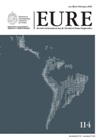Towards a polycentric city or the emergence of a wider center in the Metropolitan Area of Greater Santiago? New findings from the 2009 NSC Survey
DOI:
https://doi.org/10.4067/S0250-71612012000200003Keywords:
urban economy, mobility, segregationAbstract
Questions on commuting from the 2002 Population Census and the 2009 Casen (National Socioeconomic Characterization) survey of Chile are used for assessing two hypotheses raised in some recent articles about the Metropolitan Area of Greater Santiago (MAGS): i) the advancement of polycentrism, and ii) territorial diffusion of employment across the MAGS. Both hypotheses are based on mainstream theories of metropolitan change, and have been supported by evidence from several cities, mostly in developed countries. However, these hypotheses do not take the effects of SantiagoÍ€™s high levels of residential segregation into account. According to results obtained in this study, the MAGS is experiencing a mixed process: new centralities indeed are arising but they do not overshadow yet the concentration of employment in the wider historic centrality.
ÍDownloads
Published
How to Cite
Issue
Section
License
Copyright (c) 2012 Revista EURE - Revista de Estudios Urbano Regionales

This work is licensed under a Creative Commons Attribution 4.0 International License.
Al momento de aceptar la publicación de sus artículos, los autores deberán formalizar la cesión de derechos de autor a EURE, según las condiciones establecidas por la Revista.
Ésta establece que el autor autoriza a EURE de manera gratuita, exclusiva e ilimitada a reproducir, editar, publicar, distribuir, publicitar, comercializar y traducir el artículo, a cualquier soporte conocido o por conocer y desarrollar.
Del mismo modo, los autores aseguran que el artículo propuesto es original, no publicado y no propuesto para tal fin a otro medio de difusión.


